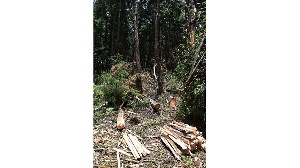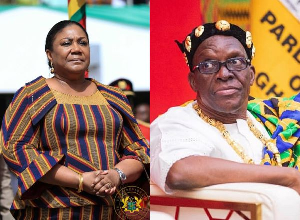In line with its Constitution that sets a target of a minimum 10 percent tree cover, Kenya devised the National Forest Programme 2016-2030 for the implementation of key tree growing and conservation programmes.
In the programme, Kenya aimed to attain a national tree cover of 10 percent by 2030, from the current 7.2 percent (which puts it in the low tree cover countries in the world). About $438 million is needed for this task.
That was until President Uhuru Kenyatta issued a directive to have the target date moved forward by eight years.
“We have now been instructed through a directive that we must achieve that by 2022,” said the head of forest conservation directorate at the Ministry of Environment and Forestry, Alfred Gichu, who also doubles as the coordinator of the REDD+ readiness activities in the country.
What this means is that Kenya will need to engage in an exercise that will result in deforested and degraded forests and other landscapes restored to 5.1 million hectares by 2022.
Ecological support
Forest ecosystems are the foundation for the success of other productive sectors such as agriculture, wildlife, tourism, industry, water, energy and infrastructure. Forest habitats support a wide variety of ecological niches and are rich in flora with about 7,000 indigenous plant species.
But Kenya’s forests are threatened with agricultural expansion, over-exploitation and unsustainable use of forest resources what with population increase and widespread unemployment.
According to the United Nations Development Programme (UNDP) Resident Representative in Kenya, Walid Badawi, Kenya loses about 12,000 hectares of forest each year through deforestation while the world loses about 4.7 million hectares of tropical forest every year.
Surveys have shown that about 12 percent of the land area which was originally covered by closed canopy forests has been reduced to about 1.7 percent of its original size. It is estimated that Kenya’s current situation leads to an annual reduction in water availability of approximately 62 million cubic metres.
Forested water towers and other catchment areas supply rivers and lakes – representing over 75 percent of the country’s renewable surface water resources – besides providing more than 15.8 billion cubic metres of water per year.
The government says it is determined to see the current plan – 10 percent forest cover by 2022 – through. After all, the country is itself party to the same global commitments that have place a rein on Kenya’s wood resources trade partners including the UN Decade on Ecosystem Restoration, Africa Forest Landscape Initiative (AFR100), Nationally Determined Contribution (NDC)—that seeks to achieve a 30 per cent emission reduction by the year 2030, and the United Nations Convention to Combat Desertification under the Paris Agreement.
“Kenya will have to invest $438 million on implementation of its tree cover strategy. If you don’t give the sector this amount then the cost of inaction is $1.5billion,” warned Mr Gichu.
“We’ll have to invest in the production of a minimum of two billion tree seedlings by 2022 if we have to achieve the presidential directive,” he said.
A co-ordinated approach is being put in place to plant trees, conserve forests and reduce greenhouse gas emissions.
“The objective is to increase tree cover and reverse forest degradation through sustainable forest management and have well managed forests that can be sustainably utilised for forest-based economy, keeping in mind the environmental benefits but without neglecting the developmental role too, including by improving the livelihoods of forest-dependent people,” said Ministry for Environment and Forestry, Principal Secretary, Dr Chris Kiptoo.
The government is now calling on corporate organisations to adopt forests to rehabilitate, private commercial owners to increase their acreage, and government organisations with land including public schools, prisons, and Kenya Railways to dedicate at least 10 percent of their land to forestry.
It also says it will fence off degraded areas especially in protected areas to allow regeneration.
Dr Kiptoo, said the focus was beyond restoration of public forests.
“Private commercial forestry can play a key role in closing the wood supply gap by offering fast-growing and renewable alternatives to natural forest felling.
‘‘The ministry is looking to promote forestry as a viable commercial enterprise,” said Dr Kiptoo.
According to Mr Gichu, Kenya has a demand gap for wood and timber resources of above 30 percent.
“Kenya has a demand of about 45 million cubic metres sawn timber and wood against a supply of 30 million cubic metres, which means we have an annual deficit of 15 million cubic metres,” he said.
Industrialisation and urbanisation are predicted to increase demand for sawn timber and wood to 66 million cubic metres by 2030. This would see the annual deficit rise to 36 million cubic metres.
Part of the plan is to increase the Kenya Forestry Research Institute seed centres from the current six to 16 centres.
Assessment of forest resources
But Kenya has to significantly invest in a system that will aid in assessing forest resources, after all the country has committed to REDD+ (Reducing emissions from deforestation and forest degradation) as a climate change mitigation mechanism. Currently, gaps exist in information on forest resources in terms of quantity, quality, growth and yields.
REDD+ was developed by Parties to the United Nations Framework Convention on Climate Change to creates a financial value for the carbon stored in forests and incentivise developing countries to reduce emissions through forested lands and investments in low-carbon paths.
Forests play an important role in carbon sequestration and in climate change mitigation and adaptation as they provide a major carbon dioxide sink that helps stabilise the global carbon balance.
At an event attended by The EastAfrican, Dr Kiptoo said the United Kingdom had accepted to support Kenya in acquiring a satellite-backed National Forest Monitoring System (NFMS). He however did not mention any timelines.
Mr Badawi said that UNDP would help Kenya achieve its NDCs.
“UNDP hopes that the ongoing NDC enhancement by Kenya places premium on Nature Based Solutions, especially the forestry sector to achieve the increased ambition which UNDP will support the Government of Kenya to achieve.”
At the regional level, UNDP has successfully supported National REDD+ readiness processes in Cote d’Ivoire, Ethiopia, Democratic Republic of Congo, Ghana, Republic of Congo, Nigeria, Uganda and Zambia among others.
According to the UN-REDD programme, developing countries would receive results-based payments for results-based actions. REDD+ includes the role of conservation, sustainable management of forests and enhancement of forest carbon stocks.
Click to view details



Africa Business News of Friday, 4 December 2020
Source: theeastafrican.co.ke

















